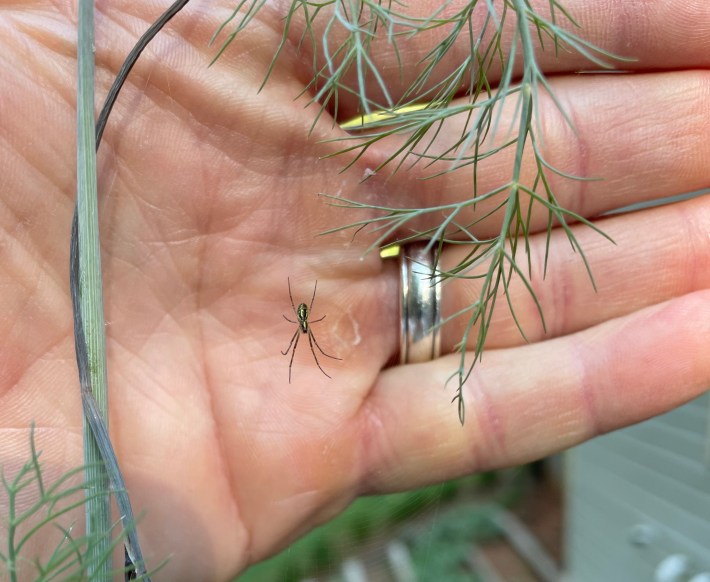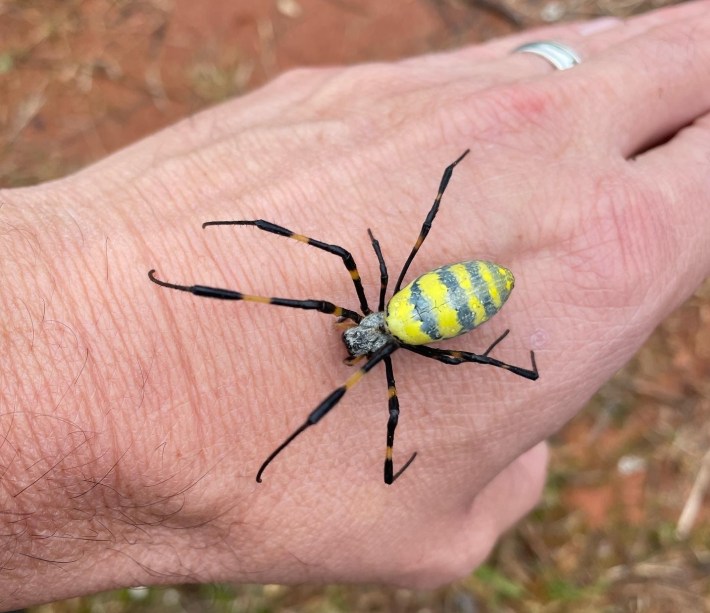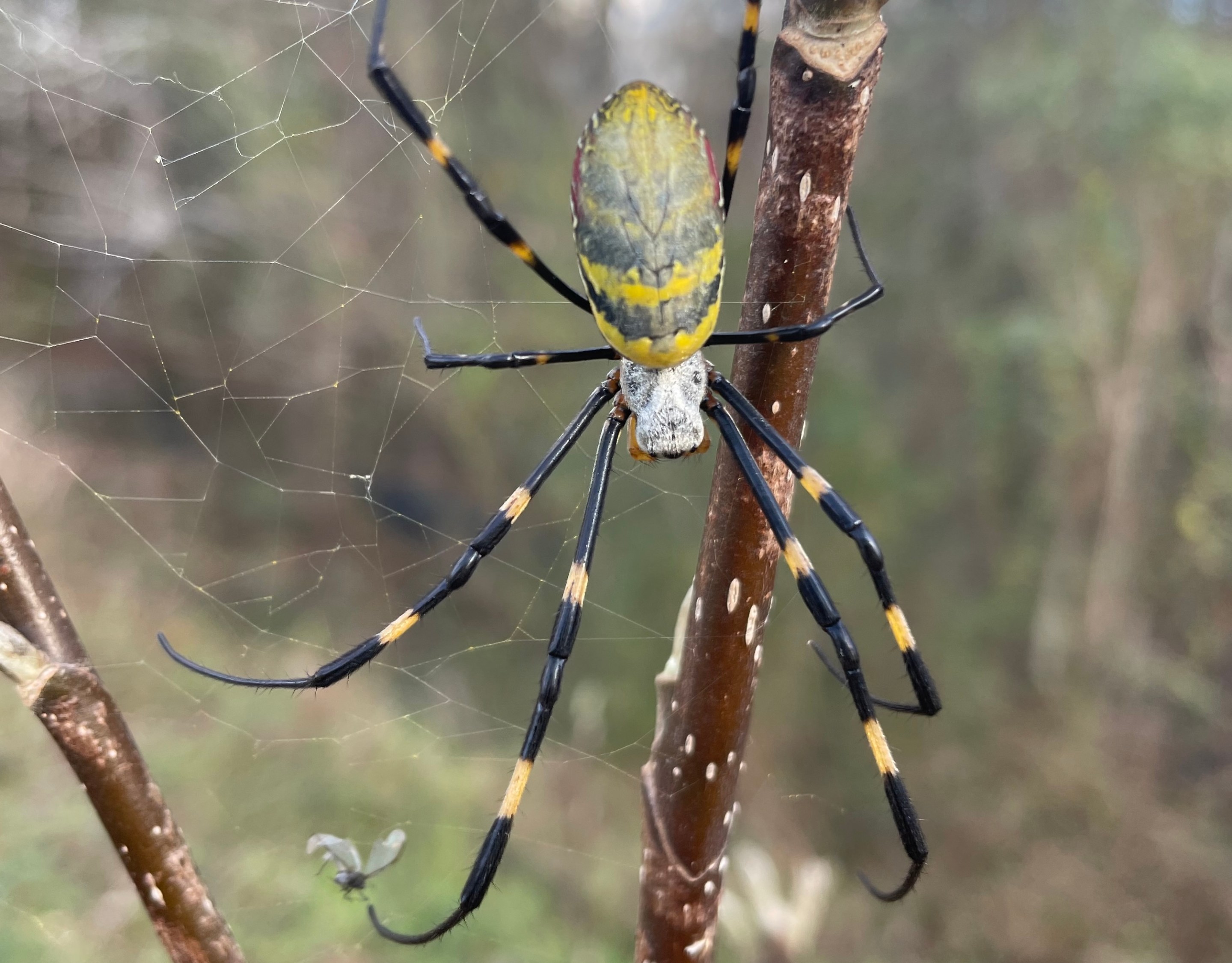If an arachnid could be an "it girl," the Jorō Spider would be Her—a long-legged golden girl who has already become the star of at least three profiles in the New York Times. She is the spider of the moment, and I say she because only the females are big and yellow and striped dark blue; male Jorō spiders are about a quarter of the size and a much drabber reddish brown, which is why they rarely get the cover.
In the U.S., the Jorō spider's claim to fame is its unexpected arrival on the scene. The spiders are native to Asia, ranging from India to Japan, and since the first Jorō spider was spotted in Madison County, Ga., in 2014, the species has made the news via headlines designed to terrify people.
These stories often arrive in spring or early summer and bode ill for anyone living in the spiders' soon-to-be-habitat. Angela Chuang, an arachnologist at Clemson University, has followed the media's coverage of the Jorō spider over the last few years. In 2022, she and Dave Coyle, a forest health and invasive species specialist at the same university, and colleagues published a paper in the journal Biological Invasions calling for more responsible journalism around the Jorō spider, at least compared to the apocalyptic headlines warning people that giant, flying, venomous spiders would be parachuting in at any moment.
Much of the coverage is riddled with misinformation—suggesting that the adults soar through the air like leggy drones or drastically overstating the spider's actual size. At reputable outlets, Chuang said, reporters often try to strike a balance, drawing readers in with sensationalism but trying to avoid demonizing the spiders. "This has led to articles with wild, sensationalist titles but a toned-down body of text, which is confusing," they wrote in an email.
What follows, I hope, is an article as toned-down and level-headed as the Jorō spider's vibe, which appears, at least interpersonally, to be relatively chill.
Where are the spiders now, and how soon will they invade my backyard?
Over the past decade, Jorō spiders have spread through Georgia and trickled out into the Carolinas, Tennessee, and Oklahoma, with a few dozen spottings in Maryland last summer. Considering the first Jorō spider was reported in Georgia in 2014, this invasion is happening much more slowly than some news stories would have you believe. Although it's possible a spider might hitchhike on a truck headed to Hoboken, scientists can't predict if or when the spiders might arrive farther north. So every story announcing that Jorō spiders are certainly invading New York or Ohio in 2024, or whatever state in whatever year, is full of hot air! For better or for worse, the spiders will get there when they get there.
Once the spiders settle in to a new home, they are hard to ignore. Coyle first encountered a Jorō spider in his home outside Athens, Ga., in the fall of 2021. As an invasive species specialist, he'd read about the spiders' first recorded appearance in his state, so it was easy to identify. "Then the next year, they were everywhere," Coyle said. Jorōs belong to a group of spiders called golden orb-weavers, named for the shiny golden silk they spin into wide, shimmering webs. "They tend to put their webs all over places where people like to be, like decks, porches, patios, carports, landscape trees and shrubs on the edge of people's property," Coyle said.
Can they fly?
Although every single story warning of flying Jorō spiders is accompanied by a huge photo of the large females, this is extremely misleading. "I think people get the idea that it's like the monkeys of Wizard of Oz, where you've got these big female spiders with wings, just kind of flapping down on your picnic and stuff," Coyle said. "That's not anywhere close to what actually happens."
Adult Jorō spiders do not have wings and cannot fly. But baby Jorō spiders can fly in a charming process called ballooning. Spiderlings the size of sesame seeds raise their butts in the air, release strands of silk, catch a breeze, and drift miles away in the wind. (Here's a cute video of the process.) This is the primary mechanism by which Jorō spiders spread to colonize new areas, and likely the main reason the spiders have spread out of Georgia.
Many species of spiders disperse this way as babies, and it's quite possible that every spring, itty-bitty spiderlings have been ballooning above your head as you walk about your neighborhood. If they have never bothered you before, why should they bother you now?

OK, so only the females are big. How big are they, really?
All golden orb-weavers exhibit what is called "female gigantism," meaning the females are not just bigger than other web-building spiders, but are bigger than the males of their own species. Don't let the word scare you; the female spiders generally grow only about as long as three inches from leg to leg (their actual bodies are about an inch long). A search for Jorō spiders exclusively turns up images of these large and lovely ladies. The small brown males are "usually in the web with the females, but nobody notices them," Coyle added.
If Jorō spiders are venomous, can they harm people?
All spiders have venom, with the exception of two families that lost their venom glands. "That's what they used to subdue, and kill their prey," Coyle said. "So it's a very standard spider thing." The venom of some spiders is painful or even dangerous to people, like the nervous-system attacking toxins of a black widow. But the Jorō spider's venom is not dangerous, just annoying. "I've had colleagues that have been bitten, and it's been between a mosquito bite and a bee sting," Coyle said, adding that these colleagues were only bitten after attempting to shove non-compliant spiders into a vial.

Are there any silver linings to this spider? Will it eat the pests in my backyard?
Some coverage of Jorō spiders note the arachnids offer all-natural pest control, feasting on moquitoes and biting flies. Certain articles have even suggested the Jorō spiders might be a welcome addition to the region to help control even more invasive species, such as invasive brown marmorated stink bugs, and even spotted lanternflies. "I'm sure they will," Coyle said. "Just like every other friggin' spider out there."
Chuang sees these arguments as attempts to push back on the way spiders are often maligned by the media, but they're not convinced the Jorō spider would offer any more effective pest control than the native spiders already living here. "To this day, I think a lot of researchers are afraid that negative press coverage on Jorō spiders will lead people to try and get rid of them in a way that harms native wildlife, such as spraying pesticides in their yards," she added.
So no pesticides, but should I be smushing them? Is this another spotted lanternfly situation?
"I don't care what you do. You can if you want, or you don't have to, or just move them out of the way, right?" said Coyle, who has been speaking to journalists about these spiders for weeks now. "It's not my job to tell you how to live your life." If it makes you feel any better (or worse), even if you killed every Jorō spider in your backyard, there are boatloads more waiting to take their place, Coyle said. Your individual actions cannot measurably impact the population. Just don't spray pesticides or general-use chemicals, which will affect all the other native arthropods living around you.
It's true that Jorō spiders and spotted lanternflies are both vibrant and immediately noticeable bugs that are new to the scene. But the similarities end there, as far as managing populations. Unlike the spider, the spotted lanternfly poses a well-known, demonstrated economic impact to agricultural crops like grapevines and maple trees, which is why the USDA "pumped in millions and millions of dollars almost immediately to try to stop this thing," Coyle said. "You could calculate dollars loss really quickly and it was a lot of friggin' money," he added. For example, Penn State received a $7.3 million grant from the USDA to develop strategies to combat the bugs. By contrast, the Jorō spider has no known impact on agriculture or human health, and its ecological impact is still currently unknown. So you can hold off on your Jorō spider kill logs.
That's a lot of money for lanternflies! So what's the state of research on Jorō spiders?
Because the Jorō spider does not pose an immediate, known threat, the USDA is not handing out million dollar grants to study the spiders. "It's a struggle to find funding," Coyle said. Although Coyle has worked on several papers on the spiders, "everything we've done has been on the side, in our, quote unquote, free time," he said.
But researchers say it's still important to research the spiders, even if it's unclear what impact they have on the environment—harmful or otherwise. "We literally do not possess the data to show that Jorō spiders are harmless to their environments," Chuang said. An invasive species' impacts are not always as obvious to the casual observer as a field of defoliated crops, and some impacts take time to develop, she added. Tracking these impacts could require years of research. Chuang and colleagues recently published the first preliminary evidence that Jorō spiders may be associated with declines in the biodiversity of native orbweaver spiders.
The spider's media presence has already spurred a wave of new research on the species, including some papers that have made headlines due to the arachnid's newfound fame. And some of the results of this research have been extrapolated beyond what is reasonable, or interpreted out of context, Chuang said. One paper in the journal Arthropoda suggested Jorō spiders were among the "shyest" spiders ever documented, leading to stories declaring the arachnids are "gentle giants." But the actual research consisted of blowing a puff of air at the spiders with a turkey baster and measuring how long the spiders remained immobilized. This experiment theoretically tests a spider's response to novel environments and the threat of predation, Chuang said. "But it's a bit of a stretch to use this as the 'proof' of the spiders being harmless to humans," they added.
Some recent papers on the spiders were published in predatory "pay-to-play" journals such as MDPI, which are technically peer-reviewed but have a history of research-quality issues. "I don't expect journalists to know this type of stuff, but from a scientist perspective, you can see that and read that and know it was garbage," Coyle said, adding that this flimsier research has helped promote hysteria around the spiders.
Is there anything else I can do to help?
If you live in North America and you see a Jorō spider, take a picture and post it on the free identification app iNaturalist. Even if you aren't sure the spider you see is a Jorō, the iNaturalist community can crowdsource identifications. This can help scientists clue in to where the species has spread. "Community science has played an important role in our understanding of the [Jorō] spider invasion and we are infinitely grateful to everyone who has contributed photos online towards this effort," Chuang said.
And in the next few years, when the next large, colorful, vaguely menacing arthropod from a faraway land is introduced to the U.S., accompanied inevitably sensationalist headlines, you might feel the urge to freak out and believe those headlines. Don't! Believe interviews from researchers that are actually studying them.
It's not the Jorō spider's fault that she's here, or that she's big and beautiful. All we can hope for now is we can live together in some kind of sustainable harmony. "I think the best-case scenario is it goes into the background, and we reach sort of some sort of ecological equilibrium," Coyle said. "I don't think they'll ever be gone gone."





